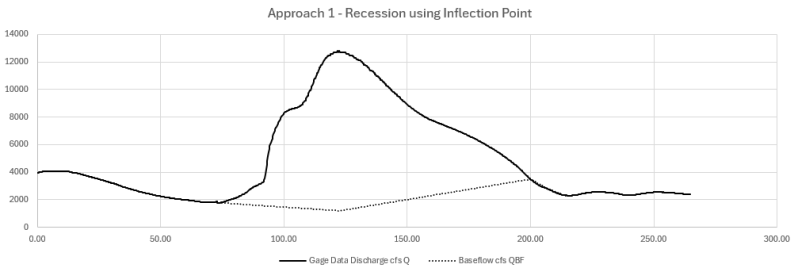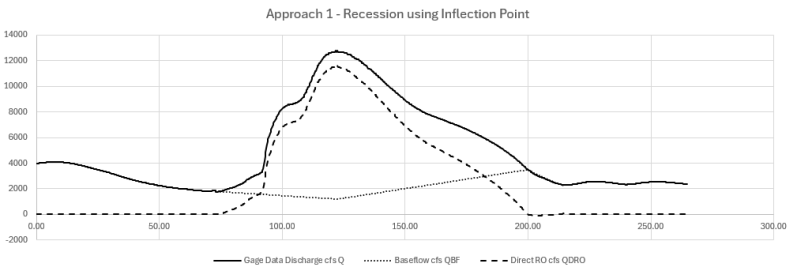Obtain the discharge data from the streamgage
Download the discharge data from a national water flow data hub (read this tutorial).
Excel Spreadsheet
Download this excel file. It shows the three methodologies to extract the Unit Hydrograph: the three methodologies differ in how they reconstruct the baseflow during a storm event.
Methodology 1 - Recession using Inflection Point
BASEFLOW:
-
During the rising limb of the flood hydrograph (left-hand side), the baseflow is assumed to keep falling at roughly the same rate as the pre-storm recession trend.
-
This decline is represented by a straight line that continues until the peak of the hydrograph.
-
From the peak to the inflection point on the recession limb (where the concavity changes on the right-hand side), the baseflow is linearly interpolated between
-
the last calculated baseflow value at the peak, and
-
the inflection point itself.
-
-
Beyond that inflection point, the reconstructed baseflow is set equal to the observed discharge data.

DIRECT RUNOFF:
Therefore, by subtracting the reconstructed baseflow from the measured streamflow data, the direct runoff is obtained. This direct runoff hydrograph starts from 0 cfs at the onset of the event.,

UNIT HYDROGRAPH:
From the direct runoff, it is then possible to derive the unit hydrograph, expressed in cfs per inch of effective rainfall (cfs/in).
The general math expression is the following:

where:
- = direct runoff (cfs) at time i
- V = total runoff volume in cubic feet
- = drainage area in square feet
We divide the runoff volume by the drainage area to convert the total volume into an equivalent rainfall depth over the basin. This normalization converts volume to depth (feet), which is then converted to inches by multiplying by 12.

The total runoff volume can be written as:


where:
- = direct runoff (cfs) at time i
- delta t = time interval between measurements, in hours (e.g., 0.25 h = 15 minutes)
- A = drainage area of the basin in square miles (mi²)
- Conversion constants:
- (to convert hours to seconds)
- (conversion from square feet to acres)
- (conversion from acres to square miles)
- Cr = 12 (feet to inches conversion)
In the case of a streamgage located on U.S. soil, the A value can be obtained by searching for the streamgage using its ID code on the following website: USGS | National Water Dashboard and then, in its information tab, retrieving the value of the DRAINAGE AREA (mi²).
Aggiungi commento
Commenti